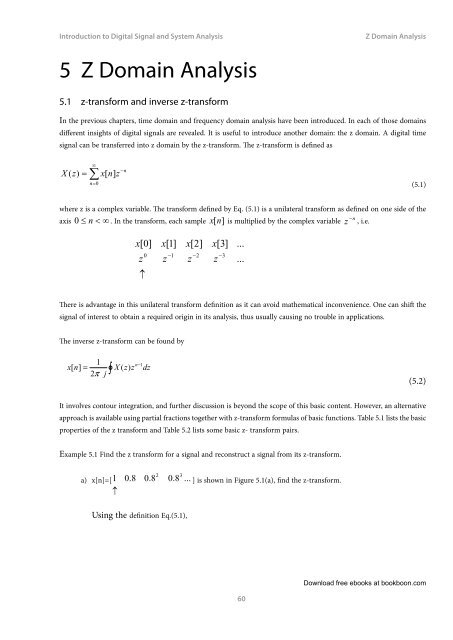Introduction to Digital Signal and System Analysis - Tutorsindia
Introduction to Digital Signal and System Analysis - Tutorsindia
Introduction to Digital Signal and System Analysis - Tutorsindia
Create successful ePaper yourself
Turn your PDF publications into a flip-book with our unique Google optimized e-Paper software.
<strong>Introduction</strong> <strong>to</strong> <strong>Digital</strong> <strong>Signal</strong> <strong>and</strong> <strong>System</strong> <strong>Analysis</strong><br />
Z Domain <strong>Analysis</strong><br />
5 Z Domain <strong>Analysis</strong><br />
5.1 z-transform <strong>and</strong> inverse z-transform<br />
In the previous chapters, time domain <strong>and</strong> frequency domain analysis have been introduced. In each of those domains<br />
different insights of digital signals are revealed. It is useful <strong>to</strong> introduce another domain: the z domain. A digital time<br />
signal can be transferred in<strong>to</strong> z domain by the z-transform. The z-transform is defined as<br />
X ( z)<br />
=<br />
∑ ∞<br />
n=<br />
0<br />
x[<br />
n]<br />
z<br />
−n<br />
(5.1)<br />
where z is a complex variable. The transform defined by Eq. (5.1) is a unilateral transform as defined on one side of the<br />
axis 0 ≤ n < ∞ . In the transform, each sample x [n]<br />
is multiplied by the complex variable , i.e.<br />
n<br />
z −<br />
x[0]<br />
z<br />
0<br />
x[1]<br />
z<br />
−1<br />
x[2]<br />
z<br />
−2<br />
x[3]<br />
z<br />
−3<br />
...<br />
...<br />
↑<br />
There is advantage in this unilateral transform definition as it can avoid mathematical inconvenience. One can shift the<br />
signal of interest <strong>to</strong> obtain a required origin in its analysis, thus usually causing no trouble in applications.<br />
The inverse z-transform can be found by<br />
x[<br />
n]<br />
1<br />
2π<br />
j<br />
<br />
n−1<br />
= X ( z)<br />
z dz<br />
(5.2)<br />
It involves con<strong>to</strong>ur integration, <strong>and</strong> further discussion is beyond the scope of this basic content. However, an alternative<br />
approach is available using partial fractions <strong>to</strong>gether with z-transform formulas of basic functions. Table 5.1 lists the basic<br />
properties of the z transform <strong>and</strong> Table 5.2 lists some basic z- transform pairs.<br />
Example 5.1 Find the z transform for a signal <strong>and</strong> reconstruct a signal from its z-transform.<br />
2 3<br />
a) x[n]=[ 1 0.8 0.8 0.8 ... ] is shown in Figure 5.1(a), find the z-transform.<br />
↑<br />
Using the definition Eq.(5.1),<br />
60<br />
Download free ebooks at bookboon.com
















